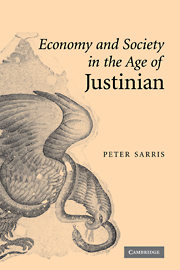Book contents
- Frontmatter
- Contents
- List of figures
- Preface
- Introduction
- 1 Egypt and the political economy of empire
- 2 The Apion archive: economic structure and estate accounts
- 3 Labour and administration: the evidence of the contractual papyri
- 4 Letters and petitions: social relations in the sixth-century Oxyrhynchite
- 5 The Apiones and their analogues
- 6 On the margins of magnate power: Dioscorus and Aphrodito
- 7 Landscapes of power: the great estate beyond Egypt
- 8 The historiography of the great estate
- 9 The great estate and the imperial authorities
- 10 The rise of the great estate
- 11 Economy and society in the age of Justinian
- Conclusion
- Bibliography
- Index
10 - The rise of the great estate
Published online by Cambridge University Press: 24 July 2009
- Frontmatter
- Contents
- List of figures
- Preface
- Introduction
- 1 Egypt and the political economy of empire
- 2 The Apion archive: economic structure and estate accounts
- 3 Labour and administration: the evidence of the contractual papyri
- 4 Letters and petitions: social relations in the sixth-century Oxyrhynchite
- 5 The Apiones and their analogues
- 6 On the margins of magnate power: Dioscorus and Aphrodito
- 7 Landscapes of power: the great estate beyond Egypt
- 8 The historiography of the great estate
- 9 The great estate and the imperial authorities
- 10 The rise of the great estate
- 11 Economy and society in the age of Justinian
- Conclusion
- Bibliography
- Index
Summary
INTRODUCTION
In chapter nine we have seen that the nature of relations between the owners of great estates and their workforce, as recorded in the laws and the papyri, was shaped primarily by private economic and contractual arrangements that developed autonomously at the grassroots of provincial society. The imperial authorities ultimately accommodated themselves to these arrangements, seeking to regulate them through legislation on coloni and autopragia, just as practices negotiated between aristocratic households and civic curiae were institutionalised from the fifth century through the emergence of the offices of pagarch and vindex. Similarly, the socially highly significant relationship between magnate households and bodies of armed retainers resulted from illicit, private arrangements, which emperors may have been obliged at times effectively to ignore, but against which they repeatedly legislated. These accommodations of the fourth to sixth centuries identify the period as having witnessed a major restructuring of agrarian social relations, one that resulted in the emergence of great estates throughout the Eastern Empire. But the process by which these estates expanded and developed invites more detailed examination.
THE ORIGINS OF THE EGYPTIAN GREAT ESTATE
As in all class-based societies, life in Roman Egypt had always been characterised by certain disparities of wealth, and, as we have seen, as early as the mid third century, the so-called ‘Heroninos archive’, along with related dossiers, reveals the existence of a number of directly managed large estates.
- Type
- Chapter
- Information
- Economy and Society in the Age of Justinian , pp. 177 - 199Publisher: Cambridge University PressPrint publication year: 2006

